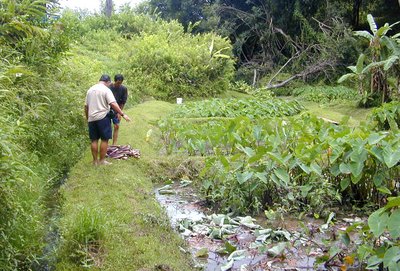Taro -- Taro Root
Taro (from Tahitian), more rarely kalo (from Hawaiian), is a tropical plant grown primarily as a root vegetable for its edible corm, and secondarily as a leaf vegetable. Its flowers are more rarely eaten. Taro is closely related to elephant ear and Caladium, plants commonly grown as ornamentals. The Genus Colocasia contains about 8 species distributed throughout Polynesia and Indo-Malaysia
Taro is a traditional staple in many tropical areas of the world, and is the base for poi in Hawai'i. The plant is actually inedible if ingested raw because of raphides in the plant cells. Severe gastrointestinal distress can occur unless the plant is properly processed first.
Taro can be grown in pond fields or in upland situations where watering is supplied by rainfall or by supplemental irrigation. Some varieties of taro can also be grown away from the tropics, in places such as Korea and Japan. In Korea, the corm is stewed and the leaf stem is stir-fried. Typical upland varieties presently grown in Hawai‘i are Lehua maoli and Bun long, the latter widely known as Chinese taro. Bun long is used for making taro chips. Dasheen (also called "eddo") is another "dryland" variety of C. esculenta grown for its edible corms or sometimes just as an ornamental plant. In Africa, this plant is typically called "taro cocoyam".
Taro production in Hawaii
Taro is usually grown in pondfields called lo‘i (in Hawaiian). The picture below shows several small lo'i in Maunawili Valley on O'ahu. The ditch on the left in the picture is called an ‘auwai and supplies diverted stream water to the lo‘i or pondfields. Cool flowing water yields the best crop. Some of the taro plants in the foreground have been harvested and the caretakers are preparing to replant the huli stacked at their feet. These are the top portion of the corm with a short piece of bladeless leafstem.

Several small lo'i or pondfields in which taro (or kalo) is being grown in Hawai‘i
The Hawai'i Agricultural Statistics Service puts the 10-year median production of taro in the Hawaiian Islands at about 6.1 million pounds (2,800 t). However, 2003 taro production in Hawai'i was only 5 million pounds (2,300 t) an all-time low. The previous low, reached in 1997, was 5.5 million pounds (2,500 t). Urbanization has driven down harvests from a high of 14.1 million pounds (6,400 t) in 1948. But more recently the decline has resulted from pests and diseases. A non-native apple snail (Pomacea canaliculata) is a major culprit in the current crop decline. Also, a plant rot disease, traced to a newly identified species of the fungal genus Phytophthora, now plagues crops throughout the state. Although pesticides could control both pests to some extent, pesticide use in the pondfields is barred because of the clear opportunity for chemicals to quickly migrate into streams and then the ocean (Viotti, 2004).
Culinary Uses
Tarro is a food staple in African, Oceanic and South Asian cultures.
People usually consume its edible corm and leaves. The corms, which have a light purple color due to phenolic pigments, are roasted, baked or boiled. The natural sugars give a sweet, nutty flavor. The starch is easily digestible, and since the grains are fine and small it is often used for baby food. Young taro leaves and stems can be eaten after boiling twice to remove the acrid flavor. The leaves are a good source of vitamins A and C and contain more protein than the corms.
In its raw form, the plant is toxic due to the presence of calcium oxalate, and the presence of needle-shaped raphides in the plant cells. However, the toxin can be minimized and the tuber rendered palatable by cooking, or by steeping in cold water overnight. Corms of the small, round variety are peeled and boiled, then sold either frozen, bagged in their own liquids, or canned.
Health Benefits
"...Considered sacred to Native Hawaiians, kalo, also known as taro, has provided sustenance for many generations. It is a way to connect to the ʻāina and Hawaiian heritage. Incorporate this nourishing, high-fiber starch into your diet today to keep your gut healthy and strong...." --Meet Kalo: Hawaiʻi Staple Food and Older Sibling The Hawaiian source of life
Anticancer and Immunomodulatory Benefits of Taro (Colocasia esculenta) Corms, an Underexploited Tuber Crop
"...Taro corms contain valuable bioactive molecules effective against cancer and cancer-related risk factors, such as carcinogens and biological agents, several pathophysiological conditions, including oxidative stress and inflammation, while controlling metabolic dysfunctions and boosting the immunological response. Such broad effects are achieved by the taro health-influencing compounds displaying antitumoral, antimutagenic, immunomodulatory, anti-inflammatory, antioxidant, anti-hyperglycemic, and anti-hyperlipidemic activities. .." source
Prebiotic Potential of Taro (Colocasia esculenta) to Modulate Gut Bacteria Composition and Short Chain Fatty Acid Production
"...Taro (Colocasia esculenta) is a high fiber tuber that holds cultural and agricultural importance in the Pacific. The high fiber content offers potential as a dietary prebiotic through the presence of resistant starch (RS). RS aids gut bacteria in the production of short-chain fatty acids (SCFA), which have health benefits to the host...Tahitian variety had the highest RS concentration of 25.1%, with no significantly difference between Tahitian, Bun Long, and Moi varieties..." source